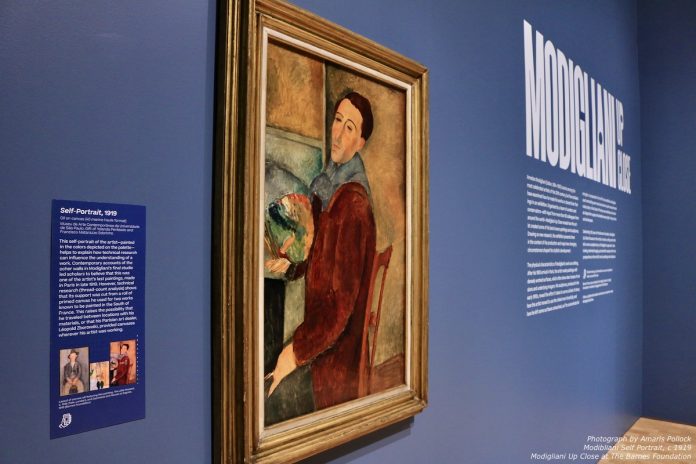On Tuesday, November 1st, the Barnes Foundation hosted an exclusive dining and viewing experience in celebration of Amedeo Modigliani for the museum’s new exhibit Modigliani Up Close.
Upon arrival, visitors were introduced to a chronological journey of Modigliani’s art—from the first paintings and sculptures, whose busts of his signature elongated faces were carved into limestone. The stones themselves recall a controversial history with the artist—it is alleged that he had come into possession of them through theft, given his economic status.
As we continued to walk through the selected pieces for Modigliani Up Close, we could see the gradual influences and changes with his technique, colors, and emotions conveyed through the canvases. Finding some of his more striking pieces (in my opinion) from The Barnes Foundation’s choice to place two of his contrasted Nudes poised next to each other, showing drastic color choices due to the canvas primed base colors.
Reclining Nude circa 1917 conveyed more sensuality, paying attention to details like smooth skin and created a look of texture for the fabric his subject reclined on, which appeared to be a bath towel beneath her body. In contrast, the Reclined Nude circa 1919 was less sensual and almost angelic in nature, with short defined brush strokes to attain a textured look for the fabric the model laid on—which gave the impression that she may have been on a carpet of some sort.
Why am I mentioning this? With most artists, the art should bring forth a feeling from within the observer, and Modigliani accomplished that with not only these two pieces, but with all the art displayed throughout the exhibit.
His work was beautiful, bold, and enriched with emotions. Modigliani was so set on cultivating emotions that one factoid (the docent giving a tour shared with fellow visitors) is that Modigliani painted the eyes to be asymmetrical. One eye was meant to look inward, and one was painted to look outward to the world. A great balance to reflect on who you are to yourself and who you are in this world.
Further into his career as an artist, you could see the stroke of his brush became more defined. His color choices seemed to become bolder. Later it seemed he turned to more subdued paintings while still capturing the personalities of his models through color and the subtleties of how his subjects were posed. As for his signature elongated faces, they looked to be more linear, with the subject’s bodies displaying techniques learned after years of influence from fellow artists.
–
In another great balance, The Barnes Foundation created an exquisite tasting menu to reflect the heritage of the artist behind the new exhibit Modigliani Up Close. Visitors were graced with a four-course meal designed by Chef Michael O’Meara, with Italian wine pairings by Philly-based sommelier Nick Amrani.
Inside the Garden Restaurant at the Barnes, we were greeted by Amrani and some of the staff from By Constellation Catering Group with a glass of Jacquart Champagne’s Mosaïque Brut. The same Champagne, which originated from Champagne, France, was paired with our first course; an Amuse Bouche of White Asparagus that was cooked al dente and tossed in what appeared to be a light coating of white vinegar with Extra Virgin Olive Oil and had Parmesan Reggiano shavings.
The amuse bouche was then delicately tethered together with the stem of chive and presented on a single serving hors d’oeuvres plate.
For the first course we choose between a Shaved Fennel & Radicchio Salad or Grilled Polpo. The dishes were paired with a wine to complement either choice; Domaine Seguin-Manuel from Burgundy, France.
Mr. Armani chose this because the wine had “Eight years of aging–so it will stand up to the spice blend of the octopus. Radicchio is difficult because there’s a lot kerosene and other things that give a bitter characteristic of it–so you always want to make sure you’re complimenting the food and never contrasting it,” stated Armani while introducing the wines to the guests. Armani continued, “For example, spicy food and tannin contrast and accentuates the spiciness–so spicy food goes very well with sweet wine.”
My friend and I ordered one of each so we could share more of the evening’s menu options. We both immensely enjoyed the Grilled Polpo dish. The tender octopus was served on top of what seemed to be a finely pulverized sundried tomato, garlic, kalamata olive, and chili pepper tapenade and then garnished with bread crumbs, fresh herbs, and edible flowers. To say it was delicious is an understatement—to say that I could happily eat that every day is much more accurate.
As for the wine, per the Sommelier’s tasting notes, we took a sip, then a bite, then another sip of the wine—and oh, how it blossomed! The second sip brought forth much stronger notes of cherries before the tobacco notes developed on your tongue. It was a beautiful pinot noir and terrific choice for our first course.
For our next course, there was a Braised Osso Bucco with farro Milanese and gremolata (paired with a Ceretto Barbaresco Asili, c 2011 Piedmont, Italy Domaine Paul Garaudet), and the Lobster Cannelloni with lobster reduction, roe butter, and basil flower (paired with a Louis Jardot Maconå-Villages Chardonnay from Macon Villages, Maconnais, Burgundy, France c. 2020).
Both dishes were succulent; the Braised Osso Bucco was savory, and even though the table settings included knives—they were pointless because the meat just came apart like a softened stick of butter. The sauce and meat were rich in flavor, and the Farro Milanese was al dente and extremely filling. The wine had strong tannin notes and a higher acidity, which definitely helped aid in the digestion of the meal.
As for the Lobster dish, it was heavenly. The meal was lighter with its flavor profile but still managed to be fulfilling. The lobster meat had a natural sweetness, which played well with the light sauce created from its own juices and butter. The Macon-Villages was a perfect selection, with a light sweetness that balanced any acidity in the Chardonnay and ended with delicious buttery notes. This wine and the lobster dish were perfectly paired.
Being food lovers, we sat next to friends, so the plate sharing continued across tables. We also tasted the Pappardelle Verde with snap peas, fava beans, arugula, and plated on top of a lemon & whipped ricotta cheese spread (paired with a Domain Paul Garaudet, Meursault, Le Limozin Vielles Vignes c. 2018). The Pappardelle Verde seemed lighter due to the pesto ‘sauce’ that Chef O’Meara created. Chef Michael’s culinary decision to incorporate the freshness of the lighter and crunchy snap peas and fava beans gave this dish a much lighter tasting profile, making what is usually considered a heavier pasta dish seem airy and bright.
The Meursault Le Limonzin Vielles Vignes chosen to compliment the dish had an earthy profile with strong lemon notes and a higher acidity level. I assume this was to help balance the heaviness of the pasta and compliment the brighter tasting notes of the al dente vegetables in it.
Of course we were sad to have the evening end, but at least it ended on a sweeter note: with two more wines and desserts. The creamy Butterscotch Budino with crushed espresso beans folded in tasted (exactly as it sounds) like a creamy butterscotch that had a crunchy coffee textured element. This was paired with an extremely sweet Emotions De La Tour Blanche Sauternes c. 2018 from Chateau La Tour Blanche in Sauternes, France. It had honey and fruit notes on the nose and was very bold in its flavor profile. An alternate pairing was what we call Ice wine in the US—picked from what the French call “Premier Cru Classé” or first growth.
The second dessert pairing was far more favorable; the Dow’s 20-Year-Old Tawny Port from Porto, Portugal, was paired with the Espresso Chocolate Piedmont Torte garnished with a delicately placed edible silver and gold leaf and a sugar crunch. The Torte had a multitude of textures beginning with the silky-smooth espresso-infused chocolate layers (dark chocolate ganache, mousse, milk-chocolate ganache, on top of a sliver of chocolate torte, ganache to secure it to the plate). It appeared to be more of an entremets or marjolaine cake than a piedmont torte, but no matter what you call it—it was divine. As for the port, I think everyone in attendance wanted to take home a bottle of it. On the nose it was wonderfully full of chocolate and caramel notes, and as it lingers on your palate–an intoxicating smoothness of tobacco notes brings the entire profile together.
–
I love visiting The Barnes Foundation because of its prestigious art collection and elegant event space. It’s the perfect place for individuals or companies to host breath-taking events. With a backdrop of beautiful works of art and grounds. Definitely a gorgeous setting to host an event. In fact, each time I attend an event at the Barnes, I am grateful for the experience and more appreciative of the artists who are displayed—from such distinguished names like Picasso, Van Gogh, Renoir, and now Modigliani.
I would be remiss not to mention that visitors to the museum can also enrich their lives with tours. All tours offer visitors an opportunity to tour and understand the individual artists and the horticulture with which the founder’s wife so beloved; and incorporated as part of The Barnes Foundation’s distinguished history.
If you would like more information on classes, hours of operation, tickets to view Modigliani Up Close, or information regarding The Garden Restaurant at The Barnes, please visit: www.barnesfoundation.org.


